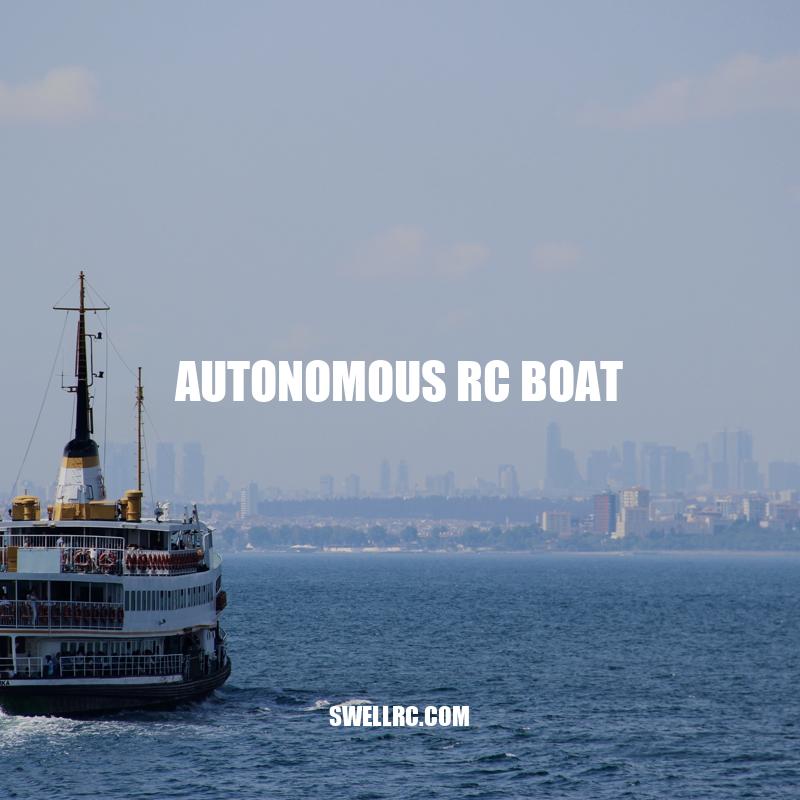Exploring the World of Autonomous RC Boats
Autonomous RC boats are remote-controlled vessels that can operate without needing human intervention. They serve as a unique and innovative way to enjoy water activities and can also be used for scientific research, search and rescue operations, film production, and marine technology experiments. Unlike regular RC boats, autonomous RC boats come equipped with high-end sensors and software components that enable them to navigate on their own. These vessels use global positioning systems (GPS), radar, and other sensors to detect surrounding objects and map their environment. The onboard computer system analyzes the information gathered from the sensors to calculate the safest and most efficient route for the boat. The boats also come fitted with hardware components, including ESC (electronic speed controller), motor, and battery. The software components include autonomous control algorithms that enable the boat to move without human intervention. Autonomous RC boats have several advantages over traditional RC boats, one of them being that they provide more precision in their movements, which is crucial for scientific research and data collection. Additionally, they require less attention and concentration from users since they are self-navigating, freeing up their hands to engage in other activities. Finally, these boats help reduce the risk of accidents by returning to their predetermined starting point if connectivity is lost.
The Mechanics of Autonomous RC Boats
Autonomous RC boats work differently from traditional RC boats. They operate using high-end sensors and software components which are designed to navigate on their own. These sensors include GPS, radar, and other sensors which monitor the surroundings of the boat. The software components include autonomous control algorithms, which help navigate the boat without human intervention. Some of the fundamental components of an autonomous RC boat include:
- Battery: The battery provides the boat with the power it needs to operate.
- Motor: The motor ensures that the boat moves in the direction set by the algorithms and sensors.
- Electronic Speed Controller (ESC): The ESC regulates the speed of the motor and ensures the boat navigates safely.
- Sensors: Autonomus RC boats use GPS, radar, and other sensors to detect objects, obstacles and to map its surroundings.
- Software Components: The Autonomous control algorithms help the boat to move without human intervention.
Companies like AutonomousStuff, Kyosho, among others, offer autonomous RC boats for sale. Additionally, users can purchase hardware components from online stores like Amazon, and use open-source software like ROS to develop their autonomous water vessel.
Are there autonomous boats?
Yes, there are autonomous boats which are commonly used for various purposes such as oceanographic research, maritime surveillance, and even transportation. Here are some examples of autonomous boats:
| Name | Description | Website |
|---|---|---|
| Sea Hunter | A diesel-electric submarine hunter designed to operate autonomously | Wikipedia |
| Roboat | An autonomous boat project in Amsterdam for transportation and infrastructure maintenance | Official Website |
| Saildrone | A wind-powered autonomous surface vehicle used for oceanic and atmospheric research | Official Website |
Some features of autonomous boats include GPS navigation, obstacle avoidance sensors, and sophisticated control systems. They are often powered by solar panels or rechargeable batteries, and can operate for extended periods of time without human intervention.
- Autonomous boats can greatly improve efficiency and reduce costs in various industries
- They can also help perform tasks that are dangerous for humans to accomplish
- The development of autonomous boats is expected to continue growing in the future
Applications of Autonomous RC Boats
Autonomous RC boats have useful applications in several areas. Here are some of the practical applications of autonomous RC boats.
- Research: Autonomous RC boats are useful for conducting scientific research, including data collection on aquatic life, water quality, and oceanography. They can also be used for mapping shallow waters and conducting surveys.
- Search and Rescue: These boats can be used for search and rescue operations, cutting the time taken to search areas and providing valuable support.
- Filming: Autonomous RC boats can also be used for filming outdoor water sports, providing an innovative and unique perspective.
- Marine Technology Testing: Autonomous RC boats can be used for testing new marine technologies or applications in real-life situations in situations that would be hazardous for humans.
- Aquaculture: Autonomous RC boats can be used to monitor fish farming and collect data on fish growth rates and health while vastly cutting down on labour costs.
Table 1: Comparison between Autonomous RC boats and traditional RC boats
| Feature | Autonomous RC boats | Traditional RC boats |
|---|---|---|
| Navigation Control | Autonomous | Manual |
| Precision | High | Lower |
| Safety | Enhanced | Less |
| Cost | Higher | Lower |
| Capability | Advanced and Self-Navigating | Basic and Manual Control |
How does a self driving boat work?
Self-driving boats, also known as autonomous boats or robotic boats, use a combination of sensors, GPS, and computer algorithms to navigate waterways and perform tasks.
Here’s how they work:
- Sensors – Self-driving boats are equipped with various sensors, such as cameras, lidar, radar, and sonar, that allow them to perceive their surroundings.
- GPS – The boats use GPS to track their position and create maps of their environment in real-time.
- Computer algorithms – Based on the input from sensors and GPS, a boat’s onboard computer uses algorithms to determine the best course of action, such as choosing the shortest route or avoiding obstacles.
- Remote control – Some self-driving boats are remotely operated by a human operator who can take control of the vessel if necessary. Others are fully autonomous and operate without any human intervention.
Self-driving boats have many potential applications, including cargo transportation, marine research, and environmental monitoring. Several companies are currently developing self-driving boats, such as Sea Machines and Boston Dynamics.
If you’re interested in learning more about self-driving boats and their applications, check out the Sea Machines website or the Autonomous Maritime Systems (AMS) Lab at the University of California, San Diego.
Advantages of Autonomous RC Boats
Autonomous RC boats offer several advantages over traditional RC boats. Let’s take a look at some of them.
- Less Attention Required: Autonomous RC boats are self-navigating and require less attention, unlike traditional RC boats that require constant manual control. This means you can engage in other activities like fishing or photography or even just relax while the boat moves on its own.
- Precision: Autonomous RC boats are more precise in their movements thanks to their sensors and software components. This precision makes them ideal for scientific research and data collection processes that require high accuracy.
- Safety: Autonomous RC boats have enhanced safety features since they are programmed to return to a predetermined location when they lose connectivity with the remote control. This reduces the risk of accidents and damage to the boat or property compared to traditional RC boats.
- Versatility: Autonomous RC boats can be used in various contexts, including scientific research, search and rescue, filming of water sports activities, testing marine technologies, and more.
- Advanced: Autonomous RC boats are more advanced and self-navigating compared to traditional RC boats, which have basic manual control features.
If you’re looking for an autonomous RC boat, some of the popular options available include the Aquanaut by Xquisite Yachts and the Scout by AirShark. You can also find autonomous RC boat kits and components on websites like Amazon and HobbyKing.
What are the benefits of autonomous boats?
- Increased safety: Autonomous boats remove the need for a human crew, reducing the risk of accidents that can occur due to fatigue or human error.
- Reduced costs: Operating and maintaining a boat can be expensive. Autonomous boats do not require salaries for crew members, which can save businesses a significant amount of money.
- Improved efficiency: As autonomous boats are powered by technology, they can operate around the clock, without taking breaks. This leads to increased productivity and faster delivery times.
Autonomous boats are already being used in a variety of industries. For example, Sea Machines offers autonomous control systems for workboats and ships, while Saildrone provides fully autonomous wind and solar-powered boats for ocean data collection.
| Benefits | Examples of autonomous boats |
|---|---|
| Safety | Sea Machines |
| Cost savings | Saildrone |
| Efficiency |
How to Get Started
So, you’re interested in getting an autonomous RC boat for yourself. What are the steps involved in getting started?
- Select the right hardware and software components: To build an autonomous RC boat, you need to purchase the necessary hardware and software components such as GPS, radar, and an onboard computer system. Make sure to choose reliable components that will work well together.
- Set up the boat’s sensors and propulsion system: Once you have the necessary components, the next step is to set up the boat’s sensors and propulsion system. This involves installing the hardware components and onboard computer system correctly and in the right place.
- Test the boat: After setting up the boat’s sensors and propulsion system, test the boat to ensure that it can move and make turns on its own and navigate the water as intended.
If you’re new to building an autonomous RC boat, you can find various resources online that can help you get started, including tutorials and videos. Some of the popular websites that offer autonomous RC boat kits and components to get you started include Amazon, HobbyKing, and Banggood.
How does self righting RC boat work?
Self-righting RC boats have a special design that allows them to automatically flip themselves back over when they capsize. Here’s how it works:
- The boat’s center of gravity is positioned low, making it harder to topple over
- The hull of the boat is designed with a V-shape, which makes it easier to pop back up when it’s flipped
- Some models have special features like weighted keels or roll bars that help the boat recover from capsizing
If you’re interested in buying a self-righting RC boat, be sure to do your research and choose a reputable brand. Websites like Amazon and HobbyKing offer a wide variety of options at different price points to fit your budget and needs.
Conclusion
An autonomous RC boat is an exciting technology that combines the fun of remote-controlled boats with the convenience of self-navigation. With the help of advanced technology, these boats can detect objects and plan the best route for themselves, allowing you to have more free time on your hands to enjoy the water activities. They have a wide range of practical applications, including scientific research, water sport events filming, and search and rescue operations. Whether you want to buy a complete, ready-to-use autonomous RC boat, build your own, or mod an existing one, there are plenty of options for you online. Whichever route you choose, remember to select the right hardware and software components, set up the sensors and propulsion system correctly, and test your boat before water trials. Many engaging, factual, and helpful resources are available online to guide you through the process of building or operating your boat. So, why not get started on building your own autonomous RC boat today and experience the excitement and thrill of unmanned navigation on your boat?



